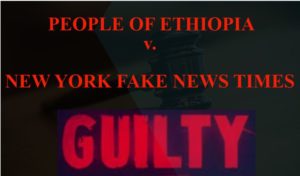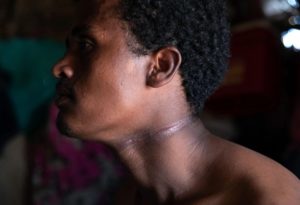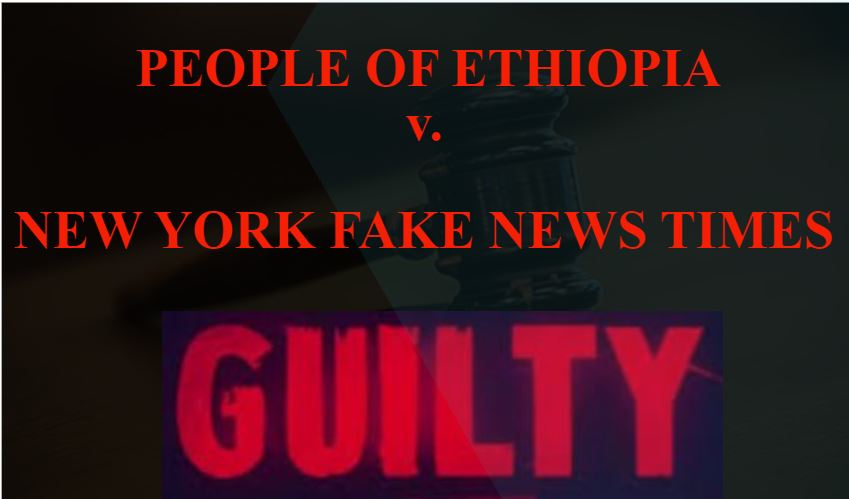PEOPLE OF ETHIOPIA v. THE NEW YORK TIMES: THE FORENSIC MEDICAL OPINION ON PHOTOGRAPH OF ALLEGED ETHNIC VIOLENCE VICTIM “ASHENAFI HAILU”

Author’s Note: In my commentary last week, I demonstrated beyond a shadow of doubt the New York Times perpetrated lies, fake news and disinformation on Ethiopia in its publication dated December 12, 2020.
I presented irrefutable evidence that the New York Times has published demonstrable falsehoods, falsehoods by unethical omission and falsehoods by failure of journalistic professionalism in reporting, corroborating and editorial oversight with the outcome of hostile disinformation on Ethiopia.
Truth be told, the New York Times is only one of many media outlets, including Reuters, BBC, Al Jazeera, Foreign Policy Online, etc., that have all pulled out their long knives against Ethiopia. In a well-coordinated media assault, these “nattering nabobs of negativism” have ganged up on Ethiopia as propagandists for the now-defunct Tigrean People’s Liberation Front (TPLF). Almost every day, they unashamedly crank out and spread lies, damned lies and disinformation on Ethiopia.
In my commentary last week, I promised to make public a forensic medical opinion on the single photograph of an alleged victim of ethnic violence the was included in the aforementioned New York Times publication. Having examined that photographic image myself as a criminal defense lawyer, I concluded it did not meet the forensic smell test of authenticity. I submitted that photograph to a panel of medical experts for examination and rendition of an opinion. Below is the report of the panel.
But first a question everyone has on their mind but is afraid to ask.
Is the New York Times the “Enemy of the People of Ethiopia”?
The old saw is, “Give the devil his due.”
Donald “Consigned to the Dustbin of History” Trump once tweeted:

Is it possible even the most pathological liar could speak truth once in a very great while?
Let me make it clear: I am not vouchsafing “Lyin’ Sack” Don.
But I am forced to ask the paramount question: . Is the New York Times the ENEMY OF THE ETHIOPIAN PEOPLE?
Here, I rest my case in People of Ethiopia v. The New York Fake News Times.
Let the reader render a verdict based on the expert opinion below and other evidence I have presented previously.
Special note of thanks and appreciation
My special thanks and appreciation to the highly qualified physicians who undertook the forensic review herein on an extremely abbreviated timeline taking time out of their extremely busy schedules. I am especially thankful for the considerable number of hours they spent in research, consultation among themselves and other colleagues and in reviewing and drafting the forensic report below, all free of charge.
============== ================ ================
Summary of Forensic Medical Opinion
The scar on the image is at least 3 months and highly likely more than 6 months old.

Scar Appearance: The scar depicted in the image appears to be a result of a surgical intervention rather than a strangulation injury.
The story line and the general wellbeing of the remainder of the skin of the alleged victim contradict one another.
There is lack of cutaneous, other anatomical, and neurological abnormalities.
=============== ================= ==============
Review of Single Photographic Image of Alleged Assault Victim “Ashenafi Hailu” in a New York Times Online Publication Dated December 12, 2020
Object of medical forensic review
A single photograph published in the New York Times on December 12, 2020 is the subject of the forensic medical analysis below. The exact date the photograph was taken and other relevant technical information on the photographic image are not disclosed in the published story. It appears the reporter took the alleged victim’s word of his injuries at face value without further independent medical examination or attempt at corroboration. The photographic image depicts the alleged victim from shoulder to the top of the head on the left side. If additional pictures of the alleged victim could be provided by the New York Times, the panel of medical forensic reviewers will be glad to undertake further examination and update their opinion accordingly.
Question presented
The question presented for a forensic analysis and opinion is whether the neck injury depicted in the New York Times photographic image and narrative description included in its report dated December 12, 2020 is consistent with injury resulting from a “noose tied around the neck” of the alleged victim while the alleged victim was being “dragged, pulled and beaten” by alleged assailants.
Skin Changes Noted
A picture of the alleged victim shows a linear scar in a somewhat perpendicular axis to the neck at the level between the hyoid bone and thyroid cartilage and extending posteriorly to the posterior edge of the sternocleidomastoid.
The scar appears well-healed without parakeratotic/orthokeratotic scale-crust on the surface.1, 3
The relevance of this on age of a scar is as follows: Normal epidermal turnover is around 27 – 28 days which gives a smooth skin devoid of scale-crust. In wound healing and most inflammatory conditions, there is a fast epidermal turnover and re-growth that results in dismaturation of the new epidermis resulting in parakeratotic and orthokeratitc scale-crust. This is especially evident in most non-medically controlled wounds where wound care is not consistently removing the scale-crust.
In the scenario described in the December 12, 2020 New York Times story, the alleged victim was in a state of non-medically controlled environment where he was allegedly assaulted and exposed to physical debris and infectious elements while being dragged by a fiber-type noose, which markedly affects wound healing and scar formation. The depicted scar on the alleged victim’s photographic image does not show signs of recent infection, rather clinically appears as a scar of a wound that has been satisfactorily handled by controlled medical intervention– similar to a wound of a thyroidectomy (a common procedure in that region) or similar neck surgical interventions. The scar lacks any markings of common strangulating materials including rope, belt, or electrical cords. If a thin (smaller surface area) yet stronger material (e.g., electrical cord/wire) was used to inflict the injury depicted in the image while the alleged victim was being dragged by the “noose”, it would have been non-survivable as the cord would tear through the skin, damage or occlude the carotid arteries and other blood vessels resulting in any of the combination of hypoxia, hemorrhage, exsanguination, and shock. When a victim is “pulled along the road” by a noose, the weight of the body under force of traction will completely occlude the vasculature and trachea (breathing apparatus) compounding the asphyxia and resulting in certain mortality.
Early hypertrophic scar and possible early keloid formation
Additionally, closer view of the scar on the image reveals a somewhat shiny cord-like nodular elevation in the median of the scar. Although this evaluation is limited by the quality of the image, this is likely and consistent with early keloid or hypertrophic scar formation where more dense fibrosis and collagen deposition starts to build during remodeling of a scar. This process generally does not start until the scar has healed well and generally indicates an age of at least 3 months.1,3, 4
The scar is well re-pigmented and even hyper-pigmented in some areas. Moreover, closer view of the scar shows re-pigmentation of the skin, in some areas to a full degree, and even in some areas of the scar, to a degree of hyperpigmentation. Because the skin depicted is a skin of color, this contrast is easily appreciated. Generally, complete macroscopic re-pigmentation of scar happens at around day 90. Since this scar shows hyperpigmentation (factored by reactive melanocytic hyperplasia in wounds), it is likely that this scar is older than 3 months and likely more than 6 months.1, 2, 3
Additional Observations:
The New York Times Story vs Photographic image of alleged victim
The skin of the left cheek, left ear, left chin, left nose, left mandibular jawline, left pre- and post-auricular, left submandibular triangle, left supraclavicular triangle, and the left shoulder (overlying the trapezius) are readily visible in the provided image from the New York Times publication. In all of these regions, one can see skin that is well moisturized, free of any abrasions, laceration, visible scar, scabbing, scale crust, rash, hypo- or hyperpigmentation, or any other trauma related abnormality giving the linear straight-looking neck scar a clear contrast to the remainder of the visible skin. The published story however mentions “dragging”, “pulling”, “beating” by the noose on the roads. The picture markedly negates the story and is extremely unlikely in relation to the timeline of the scar.
Lack of anatomical and neurological associated findings to the manner of injury
Considering the nature of the described injury, if the alleged victim was strangulated and dragged, we would have seen other associated injuries including fracture of the tracheal cartilage, facial swelling, massive sub-conjunctival hemorrhage, cervical spine subluxation, and neurological deficit including paralysis due to interruption of carotid artery flow, hypoxia, and/or injury to the spinal cord. None of these concomitant injuries were duplicated in this case to give validity to the published manner of injury.
Comparing the story to the photographic image presented by the New York Times as evidence in support of the story, we conclude that the picture presented markedly negates the published story in four most important points:
- Timeline: The scar depicted in the photographic image in The New York Times report is at least 3 months and highly likely more than 6 months old.
- Scar Appearance: The scar scar depicted in the photographic image in The New York Times report appears to be a result of a surgical intervention rather than a strangulation injury.
- Normal Background Skin: The story line in the New York Times report and the general wellbeing of the remainder of the skin of the alleged victim contradict one another.
- Lack of Associated Findings to the Described Manner of Injury: There is lack of cutaneous, other anatomical, and neurological abnormalities in the photographic image included in The New York Times report.
_____________
The foregoing forensic review is conducted by a panel of American Board-Certified Anatomic Pathologist/Dermatopathologist, Pulmonary and Critical-Care Physician, Surgeon, and Psychiatrist, all of whom concur with the observations and findings.
References:
- Robbins & Cotran, Pathologic Basis of Disease (Robbins Pathology) 9th Edition, Chapter 4 – Tissue Repair: Cellular Growth, Fibrosis, and Wound Healing.
- Chadwick, et al., “Repigmentation of Cutaneous Scars Depends on Original Wound Type”, J Anat. 2013 Jul; 223(1): 74–82.
- Bolognia, et al., Dermatology, Bolognia, 3rd Edition.
- James Peterson, Weedon’s Skin Pathology, 4th Edition.





